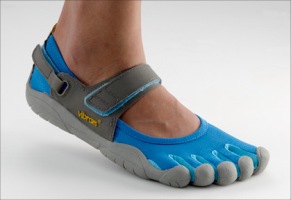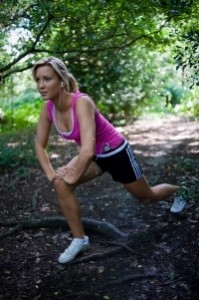 I was out running one morning about two years ago. It was a rare morning where I didn’t have music pumping in my ears. As I was approaching a turn, I began to hear an odd rhythm. It almost sounded like duck feet smacking the ground. As I got closer, I saw another runner coming towards me. The sound was coming from her shoes. She was wearing what looked like gloves on her feet as she trekked along. This was the first time I’d ever seen anyone run in the Vibram Fivefinger shoes. Flash forward two years and these shoes and the minimalist movement have grown tremendously popular. However, as with most popular things, it’s not all necessarily a good thing. There’s quite a bit of controversy over these shoes and the proper role they play in the sport of running.
I was out running one morning about two years ago. It was a rare morning where I didn’t have music pumping in my ears. As I was approaching a turn, I began to hear an odd rhythm. It almost sounded like duck feet smacking the ground. As I got closer, I saw another runner coming towards me. The sound was coming from her shoes. She was wearing what looked like gloves on her feet as she trekked along. This was the first time I’d ever seen anyone run in the Vibram Fivefinger shoes. Flash forward two years and these shoes and the minimalist movement have grown tremendously popular. However, as with most popular things, it’s not all necessarily a good thing. There’s quite a bit of controversy over these shoes and the proper role they play in the sport of running.
There’s lots of debate over the safety of minimalist running and barefoot running. There are also a lot of grey areas in the subject. While some shoes are minimal in the support they offer, they are not equivalent to a barefoot or even a Vibram. However, all members of the pro party tend to support the general theory that the stronger the foot, the better the runner will run.
Vibrams (pronounced “VEE-Brims”) claim that they allow the runner to land on their forefoot which results in optimum balance, improved stability, lighter impact, and increased propulsion. The Vibrams also claim to help correct form problems along with strengthening and stimulating muscles in the feet and lower legs.
So with such positive claims what’s the objection to this product? First Gear running shoe store owner, Gary Gregory, sees the Vibrams as a form of barefoot running and explained why he will not carry the product.
“Barefoot running is too radical of an idea from the norm, it’s too big of a departure and too big of a change for people who have been running in shoes for years.”
Gregory has owned his Wichita, KS store for 23 years and feels that the Vibrams and the barefoot trend are just another fad like so many he’s seen come and go.
To add to this, store employee and Olympic Marathon Trials qualifier Raquel Stucky shared about her experiences with the barefoot trend. “We see lots of runners that have experimented with barefoot running and have developed stress fractures, strained muscles and tendonitis as a result. Then they come to us to get fit in a shoe more appropriate for their needs. That, in itself, is the main reason we discourage new runners from the barefoot trend.”
Stucky also explained how they all see the science behind the theory and believe it to have validity, however they believe that few runners will safely follow the rigorous rules to transitioning into a minimal shoe or going barefoot.
“The most common reason runners go to a barefoot style of shoe is because they have been informed that it will improve their bio-mechanics and helps prevent the common injuries we as runners develop over time and mileage. Unfortunately, not many runners take the time to learn how to “use” barefoot shoes. This is a concept that could probably work for some runners, but I’m not sure how many are willing to take the extra time to prep their bodies for this style of running. Most runners will admit that they don’t take the time to stretch properly, eat healthy or sleep 8-9 hours a night. So most likely the majority will not take the time to educate themselves on adapting to such a radical change. There is a lot of good research and literature out there, so it’s just a matter of doing the homework.”
 While other stores choose to sell Vibrams, it seems that all share the same concerns.
While other stores choose to sell Vibrams, it seems that all share the same concerns.
Randy Mijares is a hospitalist and also a running shoe store owner. Mijares, who has a special interest in running, is the co-owner of another Wichita, KS store, GoRun. GoRun sells the Vibrams, but not without caution.
“The shoes are intended to be run in, but A: they’re not for everyone, and B: they are not meant to replace your other shoes,” said Mijares.
Mijares explained how his staff even advises some interested customers against the Vibrams, admitting, “some will buy them anyways.”
Mijares, as a medical professional, has a keen understanding of the bio-mechanical demands that minimal shoes and Vibrams create. He explained how the theory behind building up strength in the feet is optimal.
“The stronger the feet are, the more agile the feet are, and the more balanced the feet are, the better you’re going to be able to run.”
However he shared similar sentiments as the other store owners. He explained how running effectively in Vibrams is a slow, systematic process of integration and they strongly discourage anyone from completely replacing their shoes for Vibrams and especially using them for long miles.
Mijares feels that minimalist running “is the way it should have been all along.” But he was clear to express that the Vibram concept is an extreme approach to minimalism and clearly is not for every runner.
So perhaps the Vibrams are just a fad, perhaps the minimalist movement is going to be short lived. Gregory feels that this phase will pass, Mijares disagrees. Regardless of who’s right, The New York Times reported that the sales of minimalist shoes, including Vibrams, have gone up an amazing 283% in the last year. That’s a huge testament to the popularity and a major concern as so many may be using the shoes improperly.
Amidst all the controversy the Vibrams and minimalist running have created, it seems clear that the science backs the philosophy, but the runner and their commitment to learning how to run without a traditional shoe can make or (literally) break their success.
Also Read:
The Pros and Cons of Barefoot Running Shoes
Vibram Five Fingers Simulate Barefoot Running While Offering Protection
